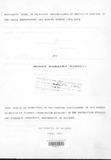| dc.description.abstract | The reasons advanced for the difference in fertility levels in 1977 by Mosley and Kalule-Sabiti can not be the same 14 years later. That is why we found it necessary to undertake this kind of study to establish the causes of variations in fertility among subgroups in Kenya using data collected in 1989.
The major objective of this study was to explain the differences in fertility levels among the various socio-economic and socio-cultural subgroups in Kenya using the Bongaarts' model of fertility. Before this the study sort to establish the accuracy of the Bongaarts' model as a method of estimating fertility levels. This was done by comparing the fertility levels obtained using the Bongaarts' model with those obtained using the Coale-Trussell P/F technique. In this case the Coale-Trussell P/F technique was used as a standard method. The intermediate variables studied were lactation, non-marriage and contraception. We used the Bongaarts' model to estimate total fertility rate, total natural fertility and total marital fertility. To test whether or not there exists any significant difference in total fertility rates obtained using the two methods, the Pearson product moment correlation and a paired t-test were used.
The data used was the Kenya ~demographic and Health Survey data of 1989. The KDHS interviewed 7,150 women aged between 15 and 49 years and 1,116 husbands whose wives were successfully interviewed.
The findings of this study indicate that among' the three
variables, breastfeeding plays the most important role in reducing fertility in Kenya and that contraception plays the least role in reducing the total natural fertility. Breastfeeding, contraception and non-marriage were found to reduce the total fecundity by 36%, the total natural fertility by 18% and the total marital fertility by 26% respectively. It was established that contraception reduces total natural fertility most among the women in Nairobi; Central province; with secondary education and higher; belonging to protestant churches; of Kikuyu ethnic group and lastly among women residing in urban areas. The effect of contraception was found to be least among the women in Western and Nyanza provinces; with no education; be longing to muslim and cathoIic religion; of Luo
ethnic group and among women living in rural areas. The study
indicates that among the regions non-marriage reduces the total marital fertility most among women in Coast province and least among those in Western province. This study has also established that the effect of non-marriage on fertility increases with an increase in the level of education and that this effect is greatest among women of the Mijikenda ethnic group; of muslim religious group; women residing in urban areas. In addition the study established that it is because of contraception that women In Nairobi and Central province; those with secondary and higher education; of Kikuyu ethnic group and women in urban areas have a lower fertility rate compared to the other subgroups. Among the women in Coast province; of Mijikenda ethnic group; of muslim
religion and among those in residing in the urban areas their
fertility rates are low basically due to non-marriage.
When comparing the two methods of estimating fertility we found that the total fertility rates obtained using the Coale Trussell model are abit higher than those obtained using Bongaarts' model.
From the above findings, it is recommended that breastfeeding should be promoted particularly for women of the working class and contraception use should also be encouraged since the fertility reducing effect of breastfeeding reduces with modernization. To encourage contraception use in areas such as Nyanza and Western provinces, the problem of high mortality in this regions should first be solved. For cases where modern contraceptive use is not accepted, alternative methods such as natural family planning should be introduced. Women in Coast province; of Mijikenda ethnic group and of muslim religion where fertility levels are low due to non-marriage, the study recommends that family planning programmes should give special attention to these sub-groups. | en |

